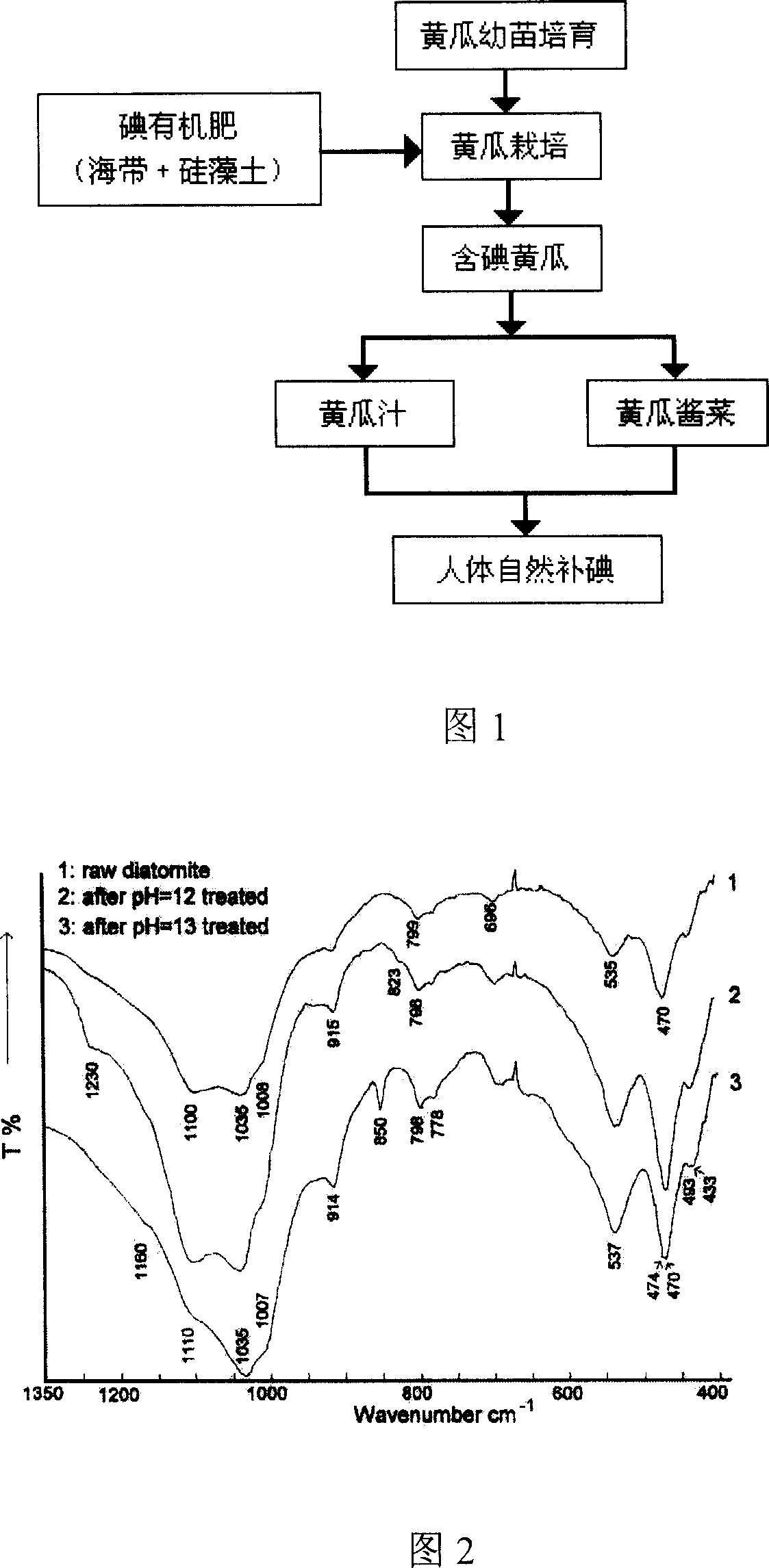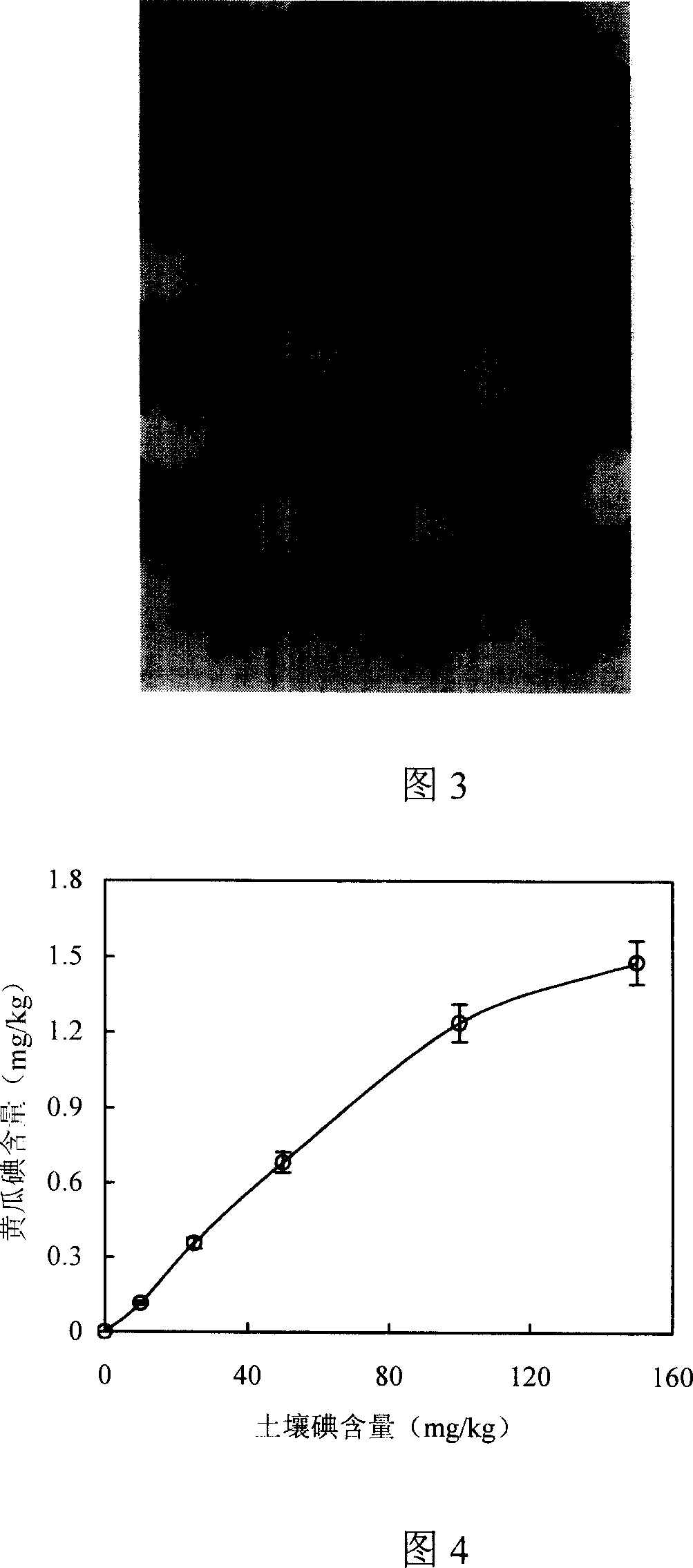Iodine-contained cucumber cultivation method
A cultivation method and cucumber technology, applied in fertilization methods, horticultural methods, botanical equipment and methods, etc., can solve problems such as difficult control of iodine concentration, difficult quantitative evaluation of biological effectiveness, and easy volatilization of inorganic iodine
- Summary
- Abstract
- Description
- Claims
- Application Information
AI Technical Summary
Problems solved by technology
Method used
Image
Examples
Embodiment 1
[0018] 1) Soak cucumber seeds in warm water at 53°C for 16 minutes, then soak them in 1% potassium permanganate solution for 13 minutes, rinse the soaked seeds with tap water repeatedly, and spread the seeds evenly on clean gauze , put it in a constant temperature box at 28°C for germination, and after 80% of the seeds germinate, they will grow seedlings on a solid substrate. The method of solid substrate seedling cultivation is: sow the seeds after the germination in a solid substrate, and place them in a temperature-controlled greenhouse. Growth, the seedlings grow to After 4 to 5 leaves, take out the seedlings from the solid substrate and transplant them in the field. This method accelerates the growth of the seedlings in the early stage, which is conducive to the cultivation of strong seedlings and early market launch;
[0019] 2) When the seedling grows to 4 leaves, transplant the seedling to the field, apply enough basal fertilizer before transplanting, and apply iodine f...
Embodiment 2
[0021] 1) Soak cucumber seeds in warm water at 56°C for 13 minutes, then soak them in 1% potassium permanganate solution for 16 minutes, rinse the soaked seeds with tap water repeatedly, and spread the seeds evenly on clean gauze , put it in a constant temperature box at 32°C for germination, and after 85% of the seeds germinate, grow seedlings in a seedbed. The method of seedling cultivation in a seedbed is: sow the seeds after germination on a greenhouse seedbed, and transplant the seedlings after they grow to 4 to 5 leaves. This method is suitable for the cultivation of large-scale seedlings, but the seedlings may not be as robust as those grown on solid substrates;
[0022] 2) When the seedlings grow to 5 leaves, transplant the seedlings to the field, apply enough basal fertilizer before transplanting, and apply iodine fertilizer in furrows, and the application rate of iodine fertilizer is controlled at 150mg / m 2 , so that the iodine content in the soil reaches 150mg / kg, t...
Embodiment 3
[0024] 1) Soak cucumber seeds in warm water at 55°C for 15 minutes, then soak them in 1% potassium permanganate solution for 15 minutes, rinse the soaked seeds with tap water repeatedly, and spread the seeds evenly on clean gauze , placed in a constant temperature box at 30°C for germination, and after 82% of the seeds germinated, they were raised on a solid substrate. The method of solid substrate seedling cultivation is: sow the seeds after the germination on a solid substrate, and place them in a temperature-controlled greenhouse to grow. The seedlings grow to After 4 to 5 leaves, take out the seedlings from the solid substrate and transplant them in the field. This method accelerates the growth of the seedlings in the early stage, which is conducive to the cultivation of strong seedlings and early market launch;
[0025] 2) When the seedlings grow to 5 leaves, transplant the seedlings to the field, apply enough base fertilizer before transplanting, and apply iodine fertiliz...
PUM
| Property | Measurement | Unit |
|---|---|---|
| Diameter | aaaaa | aaaaa |
| Diameter | aaaaa | aaaaa |
Abstract
Description
Claims
Application Information
 Login to View More
Login to View More - R&D
- Intellectual Property
- Life Sciences
- Materials
- Tech Scout
- Unparalleled Data Quality
- Higher Quality Content
- 60% Fewer Hallucinations
Browse by: Latest US Patents, China's latest patents, Technical Efficacy Thesaurus, Application Domain, Technology Topic, Popular Technical Reports.
© 2025 PatSnap. All rights reserved.Legal|Privacy policy|Modern Slavery Act Transparency Statement|Sitemap|About US| Contact US: help@patsnap.com


